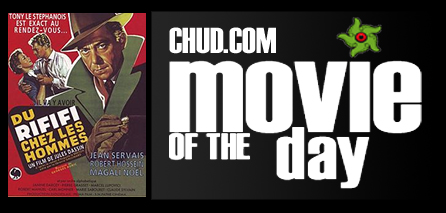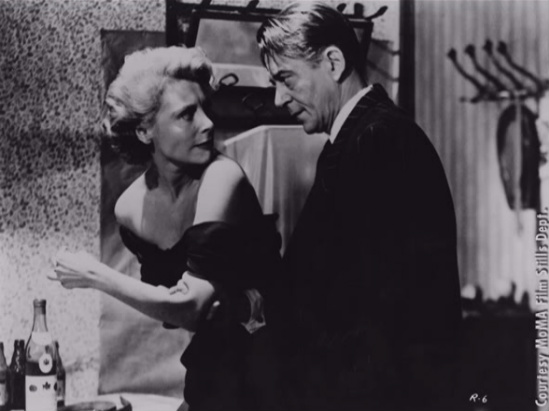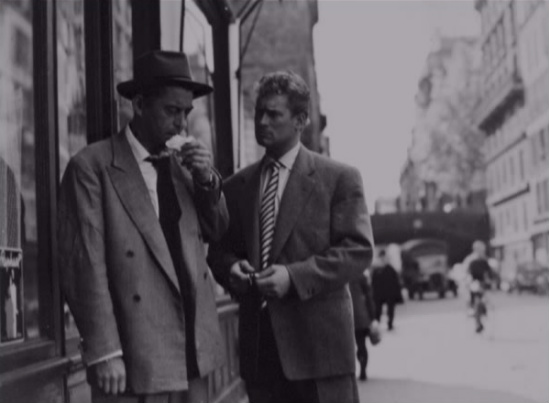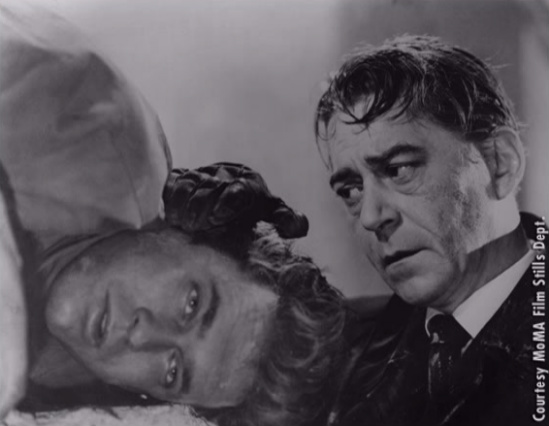The Film: Rififi (1955)
The Principals: Directed by Jules Dassin, starring Jean Servais, Carl Mohner, and Robert Manuel. Based on the novel by Auguste le Breton.
The Premise: Aging criminal Tony le Stéphanois collaborates with three other ex-cons to pull off one last heist. But even perfect planning and execution can’t predict the interference of a scumbag Parisian gangster.
Is It Any Good: Rififi is a flat-out brilliant and brutal caper that transcends the crime genre. It’s the complete antithesis of the decadent Hollywood heist films where everyone’s dressed as a GQ model and immune to perspiration. The four ex-cons of the film live in a much darker world where plans are hatched in dank basements and shootouts occur in secluded hills. There’s nothing pretty about the film – except for perhaps Magali Noel as the seductive lounge singer Viviane – but it still manages to be unquestionably beautiful in its execution, structure, photography, and moral nucleus.
At the heart of Rififi‘s story is Jean Servais as Tony le Stéphanois, an austere criminal freshly sprung after five years in the pen. He’s seriously down on his luck – when we first meet him he’s getting booted out of an all-night poker game for lack of funds. His friend Jo (who Tony took the fall for) asks him to help plan a burglary of a high-end jewelry store smack dab in the middle of a busy Parisian intersection. Jo and their mutual friend Mario are planning a straight-forward smash-and-grab plan for the robbery, but Tony’s got more class than that so he declines.
It’s not until he drops in on his old flame Mado that Tony changes his mind about the jewel heist. While he’s been doing time, Mado’s been shacked up with nightclub owner Pierre Grutter – a gangster so vile he keeps his junkie brother dangling from a string with doses of heroin in exchange for dirty work. Upset over her newfound crib and expensive clothes, Tony forces her to strip and then viciously beats her with his belt. It’s as tasteful as a woman-battering scene can possibly be. The beating takes place off screen as the camera zooms in on an old photograph of Tony and Mado during happier times.
So Tony agrees to rob the jewelers, but only on the condition that they go for the safe rather than just the goods in the front window. To bust open the safe, the three employ an Italian smooth operator names César, played by Dassin himself. The gang begins the long process of planning: casing the jewelers, disarming the alarms, and breaking in.
The caper itself is one masterfully sustained 33-minute sequence free of dialogue and music that’s been applauded for decades for its hushed suspense and shocking accuracy. It was so accurate, in fact, that crooks around the globe mimicked Tony’s plan and execution, causing Rififi to be banned in several countries including Mexico and Finland. Claudia Luther of the Los Angeles Times called it a “master class in breaking and entering” and it’s been flagrantly imitated ever since.
Dassin’s use of silence and natural sounds (breathing, footsteps, a chisel) in the scene is ingeniously constructed to ratchet up the tension to the point where an accidentally struck piano key will make your heart stop. Every subsequent heist film feels like a cheap knock-off of Rififi and, y’know, “less than.” I think two of the only films that come close to the purity of Rififi’s heist are Le Cercle Rouge and Michael Mann’s Thief. Rififi is more stark in its tone and photography than these other films, however. I wouldn’t even call it black & white – it’s more black & grey. Dassin insisted that they never shoot during the day, making the lives of crime depicted in the film that much more clandestine and effectively shady.
While the heist scene, which lasts an astounding third of the movie, has always been given the most accolades, the bookend chapters are just as engaging and nerve-wrattling in their own right. They’re all anchored by Jean Servais’ solemn, unhindered performance as Tony. Servais was a recovering alcoholic at the time and there’s something about the way he sulks through the film that feels entirely natural. And man, his face looks like 50 miles of bad road. In the first chapter he’s trying to get his shit together, confronting Mado and all. The second chapter is the heist and in the third Tony has to deal with about a dozen curveballs – from within the crew and without.
The final, feverish scene, in which Tony has given his all to make things right, kills me every time. Boston crime novelist Dennis Lehane once said that “In Shakespeare, men fall from thrones. In noir, they fall from curbs.” Well in Rififi, Tony doesn’t even get outta the goddamn car.
Is It Worth a Look: Equal parts bleak and surprisingly optimistic, Dassin’s masterpiece is a must-see for fans of the crime genre. Criterion put out a solid DVD of it back in 2001 and it’s still in print, so check it out.
Random Anecdotes: The heist scene was based on an actual burglarly that took place in 1899 in Marseilles. The hoods cut a hole in the floor of a second-floor shop to get to the jewelers below. They also pioneered the use of the umbrella!
Dassin hated the book Rififi is based on. He was particularly disgusted by the racism and necrophilia within its pages. In the book, the heist is only 10 pages long, so Dassin extended it so he could cut out the shit he didn’t like.
This was Dassin’s first film after being shunned by the bullshit House of Un-American Activities Committee. Dassin fled to France, but couldn’t find work because American distributors refused to release his films in the U.S. The French dug him though and hooked him up with Rififi after five years of unemployment.
Cinematic Soulmates: Le Cercle Rouge, Thief, Bob le Flambeur



